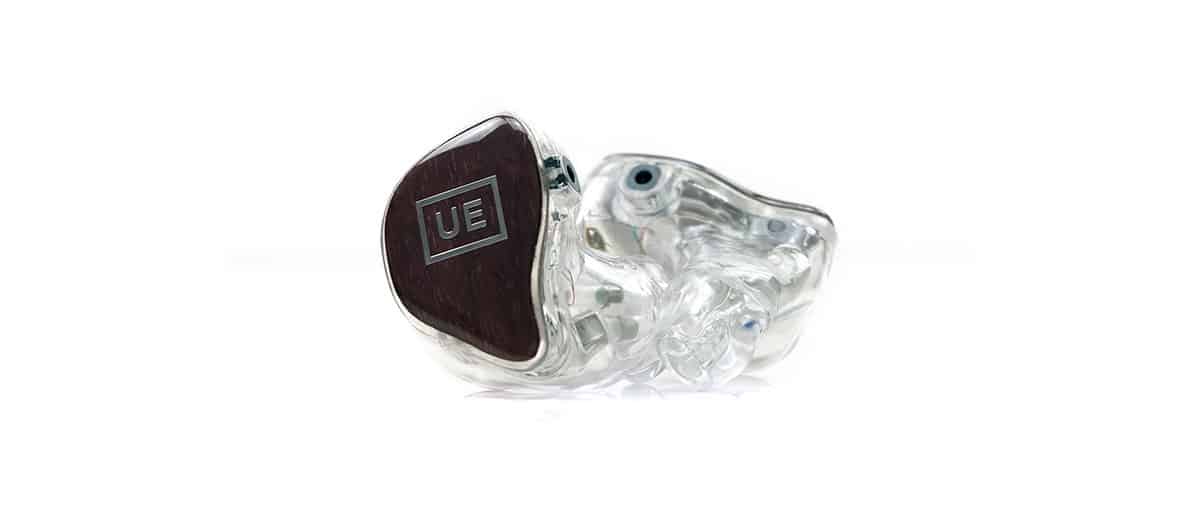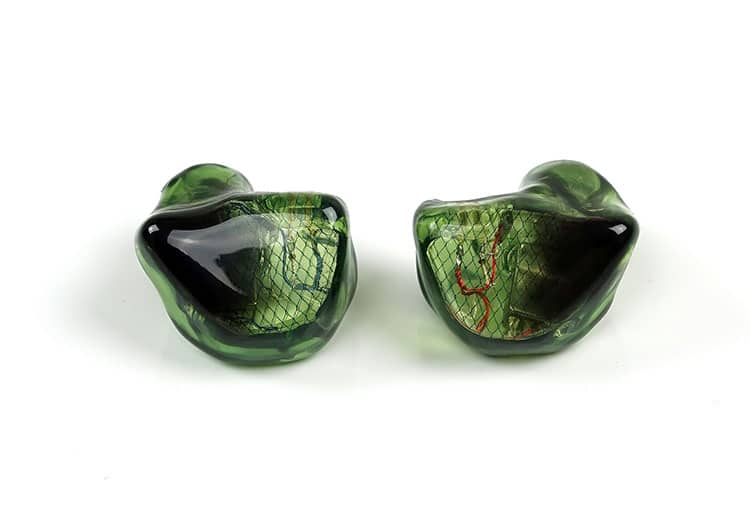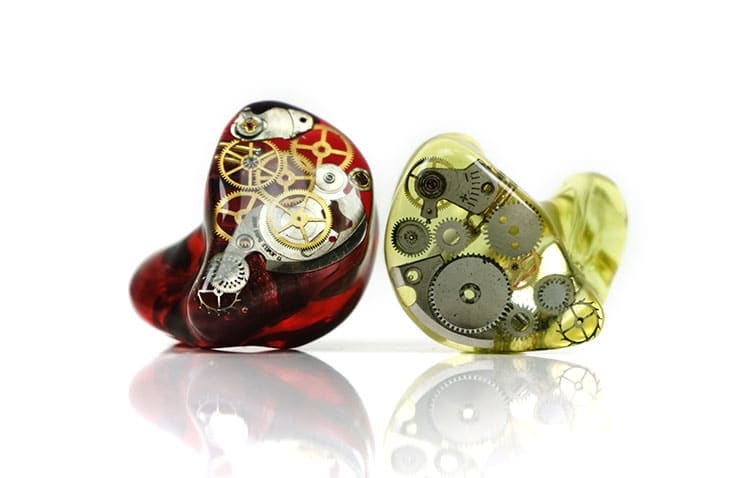Select Comparisons
The following comparisons were completed using the iBasso DX240 with the stock AMP1 MKII card.
Custom Art FIBAE 2
The FIBAE 2 first saw the light of day back in CanJam Singapore in 2017 and was launched sometime in late 2017. You can read our full review of the FIBAE 2 here.
€475
Technical
Like the UE5 Pro, the FIBAE 2 is also a dual BA driver custom monitor with a similar driver grouping of single Low/Mid and a single proprietary for the highs.
Both drivers are Knowles custom tuned for the company’s FIBAE technology with a Knowles 33357 for the highs and a larger Knowles CI series 22955 for the lows to mids.
UE does not state the origin of their drivers but given we can see the innards it is fairly clear they use similar sizing with a large BA for the low-mids and a smaller BA for the highs right at the base of the nozzle.
One of the unique features of the FIBAE 2 is that FIBAE technology which stands for Flat Impedance Balanced Armature Earphone. Basically, it renders the IEM impedance agnostic and unlikely to have any skew with mismatched impedance outputs keeping the sound signature true to its correct tuning.
The FIBAE 2 is rated quite differently from the UE5 Pro at 7.1 ohms and 113dB SPL compared to 21Ω and 119dB SPL. It was probably one of the first IEMs I encountered with such a low resistance level, something that is more commonplace in today’s monitor market.
Both are easy enough to drive but despite having the higher SPL, the UE5 Pro is the one that needs a tiny bit more juice on our test DAP, the DX240/AMP1 MKIII.
Design
Because they are both custom designed they will ideally have very unique and differing aesthetics. The pros of the FIBAE Series are more design choices compared to the UE5 Pro’s SWITCH technology which will allow you to buy several plate design choices at once and switch them as and when preferred.
The form factor is also surprisingly a little different with the FIBAE 2 having far less of a rear ridge for back pressure and a slightly shorter nozzle also. If anything, the design lines on the FIBAE 2 are a little softer than the more intricate build of the UE5 Pro. The nozzle of the UE5 PRO is also a horn type whereas the FIBAE 2 used a traditional direct exit dual bore finish.
The FIBAE 2 also has a thicker nozzle, at least on this sample which results in a tiny bit more pressure on the ear canal and slightly superior passive isolation.
The UE5 Pro SuperBaX cable is so much better than the older Plastics One stock cable design from the FIBAE 2. Not just in terms of durability and design but also in terms of dynamic range and clarity from its performance. Both are lightweight and microphonic free though but if I am a stage artist I would still want to pick the better sonic performance from the SuperBaX.
Performance
The FIBAE 2 is the smoother and warmer sounding of the two monitors and the UE5 Pro has the punchier and cleaner tuning.
CA’s presentation pushes the FIBAE 2 lows a bit further forward so the general mix is bass to mids dominant with a fairly relaxed treble presence.
Mids peak closer to around 2k for vocal presence fleshing out a nice warm and even-harmonic dominant timbre but also a more rounded note compared to the UE 5 Pro. It also has some dipping around 5-6k that takes a bit of air away from vocals and softens percussion bite.
The UE tuning is a bit flatter in the mids, slightly behind the more energetic lows and highs so it’s cleaner sounding and airier also but slightly leaner in note weight with more timbral contrast.
The UE5 Pro’s treble presence and forwardness are stronger with a more filled-in lower treble and a bit more dB gain on the 7-10k region. It gives the whole sound signature more of a lift though you do have to be more careful with matching if you are sensitive to BA sibilance which is more prevalent compared to the FIBAE 2.
The low-end of the FIBAE 2 is denser, more sub-bass dominant with more body but also slightly woolier, and not as tight as the UE5 Pro. The UE tuning has a bit more of a mid-bass punch for me, slightly cleaner and tighter also.
Lime Ears psi
The Lime Ears psi is another Polish-made custom-designed monitor reviewed by us in mid-2020. The psi marked the end of the line for their older models the LE3 and the LE3B as well as their switch-hitting LE3SW. You can read our full review here.
€625.00
Technical
The psi custom monitor packs an additional BA driver over the UE5 Pro with a single for the lows, one for the mids, and the last for the highs using a 3-way passive crossover design as opposed to a 2-way inside the UE alternative.
The big pitch for the psi is its use of a Fletcher-Munson principal bass switch allowing Lime Ears to merge their two previous and cheaper monitors, the LE3 and LE3B into one design. Basically, you get two sound signatures, a neutral version and a bassier tuning in one IEM.
The psi is rated at 46Ω impedance and 109dB SPL which is a fair bit less sensitivity and harder to drive than the 19Ω and 119dB SPL rated UE5 Pro. You can still drive them off most DAPs low gain 3.5mm TRS outputs, however, the psi is going to need more volume to match and is less sensitive to gain changes.
Design
Both are custom designs so your final aesthetics will depend once again on the choice provided by the manufacturer at the checkout. Like the FIBAE 2, Lime Ears does provide more shell designs compared to UE5 Pro and if you are just after one plate I would say the integral plate patterns from Lime Ears are more convincing.
However, the UE5 Pro SWITCH technology does give you plenty of faceplate choices that you can buy in bundles so you have more variety there to chop and change after purchasing.
The form factor of both is different. The psi is actually a smaller and shallower unit with a slightly shorter but fatter nozzle. It does not go as deep as the UE5 Pro but adds a little more pressure inside the canal to deliver a marginally superior seal.
You do have to be a little more careful though with the psi given it has that bass switch on the front plate. It is fairly durable and rated for plenty of switches but watch the humidity and moisture and keep it clean to prevent it from malfunctioning.
The UE5 Pro SuperBaX cable is leagues ahead of the psi stock cable. Again, this is Plastics One detachable 1m 4-wire copper cable with relatively average dynamics and resolution compared to the punchier and cleaner sounding SuperBax on the UE5 Pro. Both are lightweight and microphonic free but the design and IPX connector system feels better on the UE5 Pro.
Performance
With the bass switch turned off, the psi is balanced sounding, more audiophile-sensible with less weight on the low-end, and a little roll off around 80-100Hz down to 20Hz.
It has a relatively forward midrange as a result but I find imaging for male vocals to be a little bit stronger on the UE5 Pro compared to the psi. For higher pitching vocals the psi has more 2-3k presence whereas the UE5 Pro sounds airier but imaging further back.
Pinna gain is stronger from the psi up to 4-5k so upper mids have a bit more presence with a nice shimmery tone from percussion but not quite the same sparkle and upper treble presence with a drop around 7-10k in the same spot that the UE5 Pro gets a big lift.
One other note from the bass-off is a lower-mids dip on the psi which serves to cut the bass bleed and keep the mids clear sounding. It also sucks a little bit of weight from instruments that pitch just below 1k but not a huge amount. It’s more obvious on the bass-off switch because the fundamental is not as strong.
With the psi bass switch turned on everything changes. This is a bassier and warmer sound compared to the tighter, punchier, UE5 Pro. The psi bass-on setting has a lot of bass bloom which just spreads out in every direction sounding big and voluminous but also slightly soft with a longer decay.
I prefer the UE5 Pro’s better balance of depth and punch from its low-end which doesn’t crowd out the mids and keeps plenty of air in the presentation. It’s leaner sounding and cooler in the timbre but it’s much easier to pick out the details and instrumental placement at the same time.
Avara Custom AV3
Our final custom monitor comparison is the Avara Custom AV3 which is made in Indonesia and still one of the best ‘bang-for-buck‘ CIEMs out there today. You can read our full review of the AV3 here.
$340
Technical
Like the psi, the AV3 packs in an additional BA over the UE5 Pro with a 1 x high, 1 x mid, and a 1 x low using a CI series Knowles driver with a 6dB drop over its standard gain level to keep the overall tuning fairly balanced sounding.
Both monitors use a dual bore design though phase and timing control is done via a 3-way active crossover as opposed to the UE5’s 2-way integrated crossover.
The AV3 is rated at 50Ω and 120dB sensitivity with that larger CI series driver pushing up the load considerably over the UE5 PRO which is rated at just 19Ω and 119dB SPL. Surprisingly, however, these two were relatively evenly matched on our test DAP, the DX240 on a low gain setting.
It sounds almost as sensitive as the UE5 Pro in terms of responding to gain jumps and volume control so neither should present any driving issues with modern DAPs.
Design
The Avara online custom monitor builder does have plenty of design options. The clock version is probably one of their more popular ones. Indeed, the clock design was all the rage a few years ago on any custom design. Not so sure these days if that is still the case.
So, you do get a more complex design option for the AV3 compared to the UE5 and both are 3D printed so the fitting should be fairly accurate and consistent. However, as with the other compared units, the unique SWITCH technology allows you to buy multiple faceplates for the same custom UE5 Pro giving you more choice.
The form factor of these two customs is very similar save for a slightly shallow shell on the AV3 though not by much. The AV3 nozzle also seems to be slightly fatter and shorter compared to the UE5 Pro with a dual-bore direct exit rather than a recessed horn type design.
I find both to have similar isolating properties despite the AV3 having a thicker nozzle and seemingly having slightly more ear canal pressure. Might have something to do with the fact both have fairly pronounced arches on the rear that reduce pressure on the outer ear.
The AV3 uses an ‘off the shelf’ 2-pin copper or OFC 4-wire 1.2m braided-type design in a black PVC jacket. It’s nothing special but then again it’s actually the cheaper of the two customs so not that surprising it has a ‘lesser’ cable.
The UE5 Pro SuperBaX and IPX systems are much more suited to busier lifestyles or stage musician requirements. It is also a better performer in terms of dynamics and resolution.
Performance
You can tell right away that the AV3 has that additional driver covering the mids instead of a crossover point between the larger low-/mids driver and the high driver on the UE5 Pro. It simply sounds like it has an additional driver pushing a more complex midrange and generally better vocal presence and detail also.
However, you can also tell that Avara also dipped that low-end CI driver by 6dB as it rolls off considerably more than the UE5 Pro sounding punchy but comparatively sub-bass light.
As such, the focus of the AV3 staging and imaging is more mid-centric and it does indeed do better with vocals which are clearer, and better textured but in return, it is a more intimate presentation with less of a fundamental to prop up lower pitching instrumental presence.
The UE5 Pro is more contrasting with a stronger mix of low-end weight and sparkle in the highs. The mids are more dipped, flatter, and not as complex sounding. However, in return, it offers a better fundamental, more PRaT, and a little more treble energy to go along with it.
The UE5 Pro note weight is generally leaner except on the lows with a midrange timbre offering more contrast. Whereas the AV3 timbre is sweeter, more euphonic in part with a very nice balance except in the very low-end where it lacks relative power and depth.
I would pick the UE5 Pro here for EDM or expansive music tracks where you want to push the highs and lows a bit more with the AV3 more suited to mid-centric music with stronger vocal performances.
Our Verdict
The Ultimate Ears UE5 Pro is a solid little entry-level dual driver custom monitor. It has a nice balance of punchy BA lows balanced out with a sparkling treble overtone and just enough midrange vocal presence and clarity to keep the listener engaged.
Of course, it’s not just the tuning when you go custom, and here is where I think UE has hit some quality bang-for-buck territory with a very high level of finishing for a sub-$500 monitor.
It’s a very comfortable fit, very accurate also, and with a very high level of passive isolation. The stock cable is also well above average and kicks the old P1 stock design to the curb in terms of quality build and performance. Throw in a ton of changeable faceplates from the SWITCH technology and you have something rather unique also.
In terms of cons, it can be a little peaking in the highs with bright sources and the dynamic range can be improved with wider gauge cables and good power. However, if you are keeping the budget tight then the UE5 Pro is very competitive and a good place to start for customs.
Ultimate Ears UE5 Pro Specifications
- 2 proprietary balanced armatures with integrated 2-way crossover
- INPUT SENSITIVITY: 119dB @ 1 kHz, 1mW
- FREQUENCY RESPONSE: 5Hz – 22kHz
- NOISE ISOLATION: -26 decibels of ambient stage noise.
- IMPEDANCE: 21Ω @ 1 kHz
- INPUT CONNECTOR: 3.5mm headphone jack; compatible with all systems





